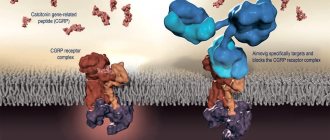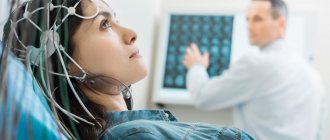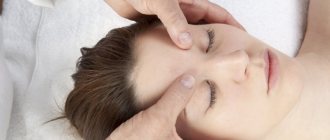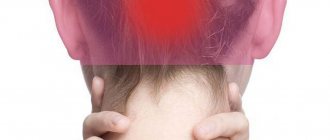Migraine
is a chronic disease that manifests itself in the form of sudden attacks of severe headache, often accompanied by nausea and, in some cases, vomiting.
Photophobia and sound intolerance may also occur before and during attacks. Migraine
Migraine is a neurological disease. It is associated with disturbances in the activity of brain structures responsible for pain and other sensations. Migraine attacks can last from several hours to 3 days. The frequency of attacks also varies: from once or twice a year to 2-8 times a month, in some cases more often.
Migraine can be considered a widespread disease - one in seven adults suffers from migraine. Migraines occur three times more often in women than in men.
Manifestations of migraine are more typical for young or mature people. Usually the disease appears at the age of 18-33 years, less often - at an older age, after 50 years - extremely rarely. Cases of the disease have been reported in children over 5 years of age. After 60 years, the severity and frequency of attacks disappear, the disease, as they say, “goes away.”
Causes of migraine
Migraine headaches are caused by changes in the lumen of blood vessels in the skin and muscles of the head. The vessels first contract and then expand sharply. The phenomena of aura are associated with a similar two-phase change in the lumen of the carotid artery, which supplies the brain. Modern research notes that migraine attacks occur against the background of increased activity of the brain and autonomic systems. After an attack, the state of these systems returns to normal. Migraine is typical for people engaged in mental work. Among people whose activities involve constant physical activity, migraine practically does not occur.
Meanwhile, the mechanism of migraine has not yet been fully studied. Factors that increase the risk of seizures
, are:
- heredity;
- low resistance to stress, mental imbalance, tendency to depression;
- chronic fatigue;
- smoking;
- diabetes;
- in women – menstruation, pregnancy, menopause;
- taking hormonal drugs.
Factors that are the “trigger mechanism” of an attack are separately identified:
- psycho-emotional stress (stress, strong emotional arousal);
- strong physical activity;
- weather changes (atmospheric pressure fluctuations);
- lack of sleep or, conversely, excessive sleep;
- alcohol (red wine is highlighted);
- some types of products (chocolate, hard cheeses, smoked meats, coffee, fish).
Nausea with migraine
More than half of people experience nausea along with other symptoms. And most of them also vomit. These symptoms may appear simultaneously with a headache. Although they usually appear an hour after the headache begins.
Nausea and vomiting can be just as troublesome as a headache. If you only have nausea, you can take your regular medications. But vomiting can prevent you from taking the pills or keeping them in your body long enough for them to be absorbed. If you have to delay taking your medications, your pain will only get worse.
If you have nausea but no vomiting, your doctor will recommend medications to relieve nausea, known as antinausea or antiemetic medications. In this case, an antiemetic will help prevent vomiting and reduce nausea.
Acupressure is very helpful in treating nausea associated with migraines. A 2012 study found that acupressure reduced the intensity of nausea after 30 minutes, and improved after 4 hours.
Simultaneous treatment of nausea and vomiting
Instead of treating nausea and vomiting separately, doctors prefer to relieve these symptoms by treating the migraine itself. If accompanied by severe nausea and vomiting, you may want to talk to your doctor about taking preventative medications.
Migraine tests
Doctors diagnose migraines by analyzing symptoms, medical history and family history, and performing a physical examination to rule out possible causes. Scans such as a CT scan or MRI can rule out other causes, including:
- Tumors
- Abnormal brain structures
- Stroke
Migraine symptoms
An attack may begin with a phase of “harbingers” - symptoms immediately preceding an attack of pain.
Below is a general list. These symptoms may appear in different combinations in different people.
Precursors usually appear several hours (in some cases days) before the onset of pain. However, quite often a migraine attack develops without going through the “precursor” phase.
Headache
Pain can occur at any time of the day, but most often it begins at night, during sleep, in the morning or immediately after waking up. Migraine is characterized by unilateral pain, focusing in the frontotemporal region with involvement of the eyeball. In 20% of cases, pain occurs immediately as bilateral; more often, having arisen as one-sided, the pain subsequently spreads to the other side. The nature of the pain is usually pulsating, sometimes bursting.
More about the symptom
Reduced threshold of excitability of sensory organs
Pain may be accompanied by an increased reaction to sensory stimuli - light, sounds, smells, touching the body - everything can increase pain. During an attack, the patient tries to retire, go to bed, darken the room, that is, reduce all external influences to a minimum.
Aura
In approximately 20-25% of cases, the disease has a specific “aura” phase. Migraine with aura is considered a classic form of the disease - this is how it was originally described. Ordinary migraine (without aura) was included in the description of the disease later.
Migraine aura is a complex of neurological symptoms that precedes and sometimes accompanies an attack of pain, and represents disturbances of various types of sensory perception that pass without consequences during the attack.
If an attack develops with an “aura” phase, this phase usually includes the warning symptoms observed in ordinary migraine. Specific manifestations of the aura can be as follows:
- the patient sees flashes of light, flickering dots, balls, broken lines before his eyes. Migraine with a similar aura is called ophthalmic
. This is the most common form of migraine with aura; - temporary blindness occurs in one or both eyes ( retinal migraine
); - oculomotor functions are impaired, double vision occurs, the pupil on the side of pain dilates ( ophthalmoplegic migraine
); - temporary weakness develops on one side of the body or only in the arm, phenomena of paresthesia may be observed - a feeling of goosebumps crawling across the body, tingling, chilliness ( hemiplegic migraine
); - speech disorders ( aphasic migraine
).
Other, more rare disorders are also possible. The “aura” phase, depending on the type of manifestation, lasts from several minutes to 1 hour.
Other symptoms
Against the background of an attack (pain attack), the following may be observed:
- nausea;
- vomit;
- photophobia;
- lethargy;
- cold hands and feet.
Types
There are many types. The two most common types are without aura and with aura. Some people have both types.
Migraine without aura
This type used to be called common migraine.
According to the International Migraine Society, people with migraine without aura have had at least five attacks that have the following characteristics:
- A headache attack usually lasts from 4 to 72 hours if left untreated or if treatment does not help.
- A headache has at least two of the following features:
- it only occurs on one side of the head
- throbbing pain
- pain level is moderate to severe
- pain worsens with movement, such as walking or climbing stairs
- The headache has at least one of these features:
- Sensitivity to light appears (photophobia)
- Sensitivity to sound appears (phonophobia)
- You experience nausea with or without vomiting or diarrhea
- The headache is not caused by another health problem or diagnosis.
Migraine with aura
This type was previously called classical, complicated and hemiplegic. Migraine with aura occurs in 25 percent of people.
According to the International Migraine Society, you must have had at least two attacks with the following characteristics:
- An aura that disappears may return and includes at least one of the following symptoms:
- vision problems (the most common aura symptom)
- sensory problems such as numbness, tingling, or dizziness
- problems with speech or language
- trouble moving or weakness that may last up to 72 hours
- brain stem symptoms:
- difficulty communicating or dysarthria (fuzzy speech)
- dizziness
- tinnitus
- Hypacusis (hearing problems)
- diplopia (double vision)
- ataxia, or inability to control body movements
- clouding of consciousness
- vision problems in only one eye, including flashes of light, blind spots, or temporary blindness (when these symptoms occur, they are called retinal migraines)
- An aura that has at least two of these traits:
- at least one symptom gradually gets worse over five minutes or more
- Each aura symptom lasts from five minutes to one hour (if you have three symptoms, they can last up to three hours)
- at least one aura symptom affects only one side of the head, including problems with vision, speech, or language
- aura occurs with headache or an hour before headache begins
- The headache was not caused by another medical problem, and a temporary ischemic attack was ruled out.
The aura usually occurs before the headache begins, but it may continue during the headache. In some cases, the aura may begin at the same time as the headache.
Chronic migraine
Chronic headaches used to be called combined or mixed headaches because they can have features of migraines and tension headaches. It is also sometimes called severe and can be caused by overuse of medications.
People with chronic migraines experience severe tension more than 15 days per month for 3 or more months. More than eight of these headaches are migraines with or without aura.
- severe headaches
- major incapacity
- depression
- another chronic illness, such as arthritis
- other serious health problems (comorbidities), such as high blood pressure
- previous head or neck injuries
Acute migraine
Acute is a general term that is not diagnosed as chronic. Another name for this type is episodic. People who suffer from episodic migraines experience headaches up to 14 days a month. Thus, people with episodic migraines suffer less headaches than people with chronic ones.
Vestibular migraine
Vestibular is also known as vertigo. About 40 percent of people have some symptoms related to the vestibular system. These symptoms make it difficult to balance, cause dizziness, or both. People of any age, including children, can experience vestibular migraines.
Neurologists typically treat people who have difficulty coping with migraines, including vestibular migraines. For this type of migraine, the same medications are prescribed as for its other types. Vestibular migraines are also sensitive to foods that trigger migraines. So, you can prevent or reduce dizziness and other symptoms by making changes to your diet.
Your doctor may also recommend that you see a vestibular rehabilitation therapist. He or she can teach you exercises that will help you maintain balance when your symptoms are at their worst. Because they are so debilitating, you and your doctor may want to discuss taking preventive medications.
Optical migraine
Optical is also known as ophthalmic, ocular, ophthalmic, monocular and retinal migraine. This is a rarer type with an aura, but unlike other visual auras, it only affects one eye.
The International Migraine Society defines retinal migraines as attacks of completely reversible and temporary vision problems in only one eye. Symptoms may include:
- flashes of light called scintillations
- blind spot or partial loss of vision called scotomata
These vision problems usually occur within an hour of the headache. Sometimes optical migraines are painless. Most people with optical migraine have previously had another type of migraine.
Physical activity can trigger an attack. These headaches are not caused by eye problems such as glaucoma.
Complex migraine
Complex headache is not a type of headache. Some people refer to "complex migraine" as migraine with aura, which has symptoms similar to those of a stroke. These symptoms include:
- weakness
- speech problems
- loss of vision
Seeing an appropriate specialist will help you get a correct and accurate diagnosis.
Menstrual migraine
Menstruation-related pain affects up to 60 percent of women. They may or may not be accompanied by an aura. They can also occur before, during or after menstruation and during ovulation.
Research has shown that menstrual migraines are more intense, last longer, and are more likely to cause nausea than other migraines.
In addition to standard treatment, women with menstrual migraines will benefit from medications that affect serotonin levels, as well as hormonal treatments.
Acephalgic migraine
Acephalgic is also known as migraine without headache, aura without headache, silent and visual migraine without headache. An acephalgic migraine occurs when a person experiences an aura but does not have a headache. This type is not uncommon among people who begin migraines after 40 years of age.
Visual aura symptoms are the most common. With this type, the aura may appear gradually, with symptoms spreading over several minutes and moving from one symptom to another. After visual symptoms, people may experience numbness, problems speaking, and then feel weak and unable to move parts of their body normally.
Hormonal migraine
Also known as exogenous estrogen headaches, hormonal headaches are associated with female hormones, usually estrogens. These include migraines during:
- your menstruation
- ovulation
- pregnancy
- perimenopause
- the first few days after starting or stopping medications that contain estrogen, such as birth control pills or hormone therapy
If you are taking hormone therapy and your headaches are getting worse, your doctor may suggest:
- adjust the dose
- take a different type of hormone
- stopping hormone therapy
Migraines from stress
Stress migraines are not a type of migraine recognized by the International Migraine Society. Stress may be the cause.
There are headaches that arise from stress. They are also called tension headaches. If you think stress may be causing a migraine, try yoga for relaxation.
Cluster migraine
Cluster is also not included in the classification of the International Migraine Society. However, cluster headaches do exist. These headaches cause severe pain around and behind the eye, often accompanied by:
- tearing
- nasal congestion
- redness
They can be triggered by alcohol or excessive smoking. You may suffer from both cluster headaches and migraines.
Vascular migraine
Vascular is not included in the classification of the International Migraine Society. Vascular headache is a term some people use to describe the throbbing and throbbing headaches caused by migraines.
Migraine Treatment Methods
Migraine treatment
Migraine treatment is a complex and lengthy process that requires an individual approach to each case of the disease. Treatment measures are aimed at reducing the frequency, duration and severity of attacks, and during an attack, at reducing the severity of symptoms.
Drug treatment of migraine should be accompanied by appropriate lifestyle adjustments. You should avoid overwork, spend more time in the fresh air, follow a sleep and eating schedule, and exclude foods that can provoke attacks.
Neurologists at the Family Doctor will help you quickly and effectively eliminate migraine pain and select an individual course of preventive treatment, including massage and reflexology sessions.
Specialist consultation
The doctor’s task is to select the necessary set of medications. This complex includes drugs that can help in the acute period, as well as drugs aimed at preventing attacks.
Make an appointment Do not self-medicate. Contact our specialists who will correctly diagnose and prescribe treatment.
Rate how useful the material was
thank you for rating
Migraine and headache: tension
Tension headaches, the most common type of headache, have some similar symptoms. However, migraines are also associated with many symptoms not associated with tension headaches.
And tension headaches can be characterized by:
- mild to moderate pain
- constant pain
- pain on both sides of the head
These symptoms are typical only for migraines:
- moderate to severe pain
- throbbing pain
- inability to carry out one's usual activities
- pain on one side of the head
- nausea with or without vomiting
- aura
- sensitivity to light, sound, or both
How does an attack proceed?
A classic attack goes through 4 phases in its development: prodromal phase, aura, painful attack and recovery. Some people have all phases, others only some of them.
The prodromal phase is the precursors. About a day before the onset of an attack, a person begins to have a keen sense of smell, he is drawn to sweets, his mood changes, he wants to constantly yawn, and he is bothered by fatigue and weakness. Not everyone feels these signs; many do not have time to pay attention to them.
The aura lasts from 5 minutes to several days. Doctors divide aura into positive and negative. Positive – a person sees or feels something that is objectively not there. This can be bright light at the edges of the visual field, sparkling geometric shapes, most often zigzags, stars, stripes, spirals. They enlarge and fill the entire field of view. People may see pulsating lines around objects and may experience double vision or a feeling of blindness in one eye.
The aura is called negative if part of the visual field falls out. A black spot appears in the center or edges, sometimes it replaces the lateral fields of vision.
At the same time, some people experience neurological disorders in the form of numbness, “crawling”, and tingling on the side of pain. Unpleasant sensations begin in the hand and spread to the head and half of the tongue. There is weakness (paresis) in an arm or leg. It becomes difficult to speak, words are not remembered, it is difficult to express your thoughts.
Next comes the pain phase, during which the head throbs, the slightest rustle or light worsens the condition. The patients are pale, many feel nauseous, and vomiting does not bring relief. Some people want food rich in carbohydrates at this time - buns, potatoes, others cannot even swallow water. Many describe the condition as “your head is about to explode.” Your neck and shoulders may hurt. The torment sometimes lasts up to 3 days.
For some, the pain attack ends on its own, and for others after massive administration of medications. After the pain ends, a sound sleep most often follows.
Recovery from an attack occurs in different ways. At first, almost everyone experiences an increase in the amount of urine they produce, and then some feel exhausted for about a day, while others feel a surge of strength.
Risk factors
Statistics show that most often women of reproductive age from 15 to 45 years suffer from migraine attacks. The most dangerous age in this sense is from 35 to 40 years. Among men, only 6% of the country's total population suffer from the disease.
The mechanism of attack development has been sufficiently studied, but the exact causes of migraine are unknown. The main predisposing factor is heredity. If you carefully collect your family history, it turns out that there were already people in your family with such attacks. As a rule, women and men of the same kind are affected, and the degree of relationship may be different. The disease can develop both in direct relatives - sisters or daughters, and in granddaughters, cousins and second cousins. The pathological gene is transmitted through the maternal line. This is confirmed by statistical data: if the mother has seizures, then the probability of the disease in the child reaches 90%, and if the father has seizures, then only 20%.
If a patient experiences a headache, and there is no mention of such patients in the family history, then with a high degree of probability it is a tension headache or other diseases.
Recommendations
A consultation with a neurologist and magnetic resonance imaging of the brain are recommended.
| • | Leading specialists and institutions for the treatment of this disease in Russia: |
| Doctor of Medical Sciences, Head of the Department of Russian State Medical University, Professor, Academician of the Russian Academy of Medical Sciences Gusev E.I. | |
| • | Leading specialists and institutions for the treatment of this disease in the world: |
| G. AVANZINI, Italy. |
Incidence (per 100,000 people)
| Men | Women | |||||||||||||
| Age, years | 0-1 | 1-3 | 3-14 | 14-25 | 25-40 | 40-60 | 60 + | 0-1 | 1-3 | 3-14 | 14-25 | 25-40 | 40-60 | 60 + |
| Number of sick people | 0.01 | 0.01 | 0.01 | 100 | 250 | 250 | 250 | 0.03 | 0.03 | 0.03 | 400 | 1000 | 1000 | 1000 |
general description
Migraine without aura (G43.0) is a chronic relapsing disease characterized by sudden attacks of intense pain in the head, often pulsating in one part of the head.
Prevalence: 3.4 per 100 thousand people. Migraine often debuts between the ages of 20 and 35.
There are unilateral (up to 99%) and, rarely, bilateral headache localizations. As the disease progresses, the side of the headache may change.
A migraine attack is triggered by stress, weather changes, lack of sleep or excess sleep, eating certain foods (chocolate, nuts, cheese), drinking alcohol, and fasting. In women, headache attacks may be associated with the menstrual cycle. There may be a hereditary history of headaches.











